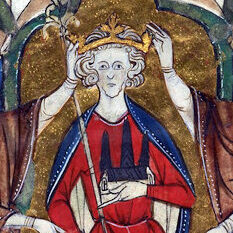On 12 April 1258, Simon de Montfort joined six other barons in a sworn confederation against the Lusignans, the four younger half-brothers of Henry III. A drawing of the original document shows the arms of five of the confederates.
At the far left are those of Roger Bigod, earl of Norfolk. He had no personal disputes with the Lusignans and fought at neither Lewes nor Evesham, but did support Simon’s regime. He died in 1270.
The next arms show Simon’s famed fork-tailed lion. He was married to Henry’s sister Eleanor, making him a brother-in-law of the Lusignans, but he was intensely jealous of the most anglicized of the Lusignans, William de Valence. Simon twice threatened to kill William while parliament was in session.
The arms in the middle belong to Peter of Savoy, who was Queen Eleanor’s uncle. He and the queen viewed the growing influence of the Lusignans over Edward, the heir to the throne, with alarm. He returned to his native Savoy in 1262 and died there six years later.
The next arms are those of John Fitz-Geoffrey. It was his deadly quarrel with Aymer de Valence, the youngest of the Lusignans, that led to the sworn confederation. He died in 1258. His son John led the massacre of the London Jews in 1264.
At the far right are the arms of Peter de Montfort, the lord of Beaudesert who was of no relation to Simon. The two Montforts were the only confederates to remain firmly allied against the king and died together at Evesham in 1265.
The other two confederates were High Bigod, the younger brother of Roger, and Richard de Clare, earl of Gloucester. Hugh was a rising star at court and fought for the king at Lewes. He died in 1266. Richard de Clare, earl of Gloucester, had been a good friend of the Lusignans until the queen weaned him away from them with a lucrative marriage for his daughter. Like many of the barons, he was back and forth throughout the coming conflict, but was a loyalist at his death in 1262.
On 8 May 1258, three of the confederates–Simon, Peter, and Hugh Bigod–left on an embassy to France. They were accompanied by two of Lusignans, Guy and Geoffrey. Apparently they all got along fine, but things would change drastically when parliament met in June at Oxford.
The confederation is born

